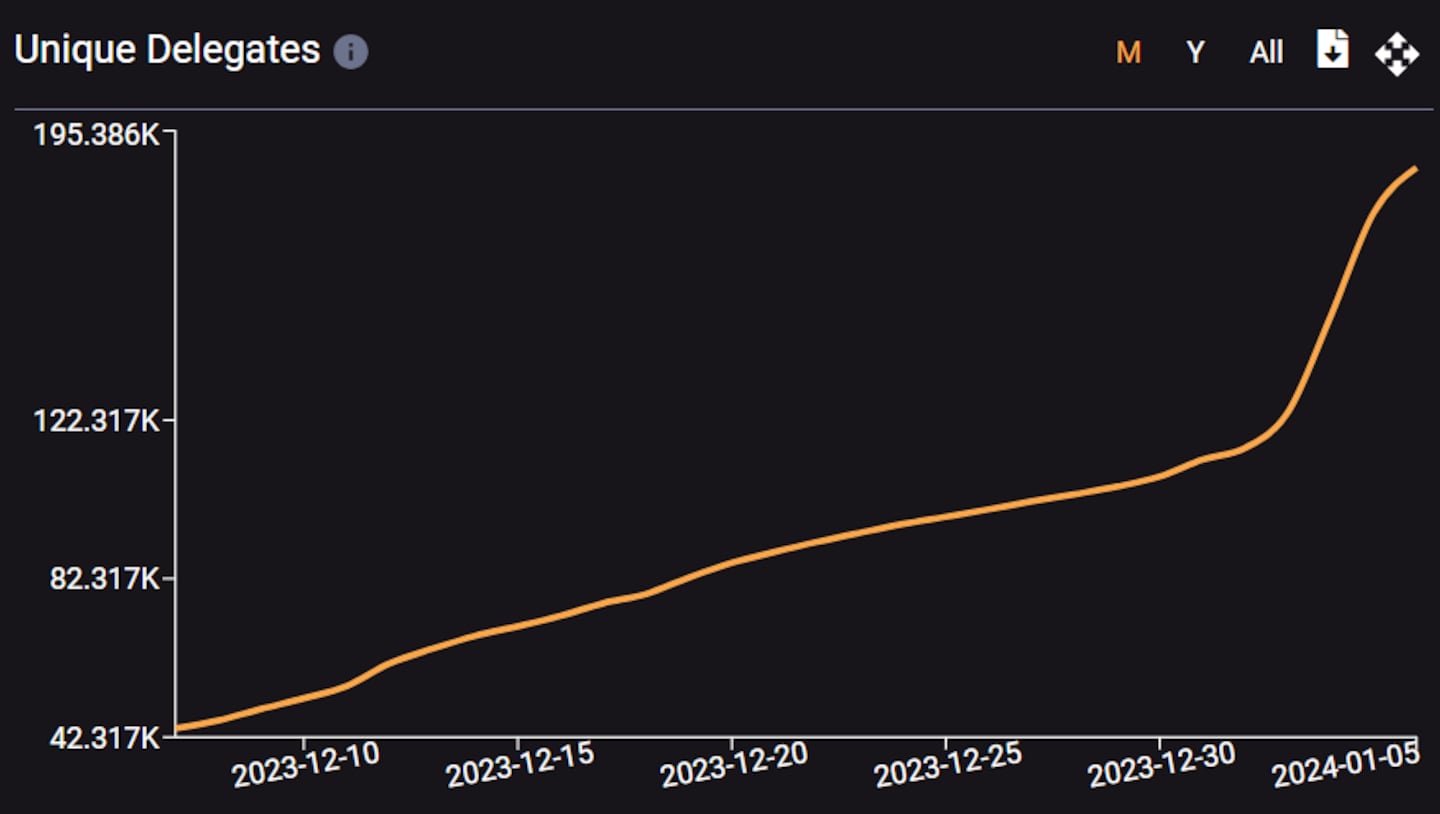- Celestia is becoming a target community for airdrops from other projects focusing on blockchain modularity.
- Staking as little as 1 TIA made some users eligible for one of the upcoming airdrops.
- This trend may continue as more projects use Celestia as their data availability layer.
Stakers on Celestia, a new modular data availability network, have been selected to benefit from two forthcoming airdrops.
One of them is from Saga, a scalable platform for launching dedicated blockchains, which views Celestia as a valuable partner.
“Celestia is one of our earliest partners,” Rebecca Liao, co-founder and CEO at Saga, told DL News, adding that Saga has provided automated rollups on Celestia for almost a year.
“The most loyal Celestia community members are those who received their TIA and then staked it immediately, so our airdrop is targeted towards those stakers,” Liao said.
This highlights a growing trend of projects choosing to airdrop tokens to those helping secure the Celestia network through staking.
This year is set to be pivotal for airdrops, with giants such as interoperability protocol LayerZero already confirming a token distribution in the first quarter of the year.
Last month, Jito, a liquid staking protocol on Solana, sparked a flurry of interest in airdrops after it distributed a minimum of $20,000 worth of its JTO governance token each to early users.
Celestia stakers increase
Saga is not the first project to announce an airdrop for Celestia stakers since the start of the year.
On January 2, Dymension, a network for easy deployment of application specific blockchains, also announced an airdrop of its soon-to-be-launched DYM token. Of the 70 million DYM set aside for the airdrop, 20 million will be allocated to users who staked at least 1 TIA.
Two days later, Saga followed up with its own announcement, including more than 27,000 users who staked at least 23 TIA before December 1, 2023. Saga has not yet revealed how many SAGA tokens it will allocate to the airdrop.
As the DYM and SAGA tokens have not yet launched, and therefore can’t be traded, it is still unclear how much the airdrops will eventually be worth. On the futures trading platform Aevo, which already lets users bet on the price on DYM, the token trades for around $4.70.
In response to these airdrop announcements, more DeFi users have started staking TIA in hopes of securing future airdrops.

On the day of the DYM airdrop announcement there were about 124,000 unique stakers. As of today, this number has increased by over 50% to more than 186,000 unique stakers.
About 483 million TIA, or 48% of the total circulating supply, is staked with validators, up from 480 million on January 2.
Celestia is a modular data availability network designed to offer layer 2 blockchains a scalable foundation to build on.
It enables developers to launch a blockchain without the need for their own validator network; they now have the option to use Celestia’s instead of having to bootstrap their own.
Celestia focuses on data storage and ordering for transactions, while the execution is left to other blockchains, increasing efficiency.
Celestia stakers play an instrumental role in this ecosystem as they are not only securing the network, but also the networks that rely on Celestia for data availability.
A similar vision for a modular future
Dymension enables developers to easily deploy dedicated blockchains, which it calls RollApps. Saga is also making it easier for developers to deploy dedicated blockchains, which it calls Chainlets.
With a similar vision for a modular future, the Celestia community was a strong target for their upcoming airdrops.
Other communities, like ATOM stakers, were also included in both airdrops as they underpin the Cosmos appchain ecosystem, of which Celestia is a part.
This trend in rewarding the Celestia staking community appears to have aided projects like MilkyWay, a liquid staking protocol for Celestia stakers.
Since the DYM airdrop announcement, its total value locked has more than doubled, increasing from $8.5 million to more than $19 million.
More airdrops on the horizon
Airdrops have proven a great marketing tactic for new crypto projects, and can also help them decentralise and build a strong community.
Highly-anticipated projects — such as Berachain and Manta, which also rely on Celestia’s infrastructure — are set to launch later in 2024.
As such, many Celestia stakers are hoping such projects will also reward them with airdrops.
Still, there are also signs that some stakers may be trying to take advantage of the situation.
The recent increase in Celestia stakers was accompanied by a decrease in the average staked amount per user.
This could signal that smaller participants are beginning to stake, but a more likely scenario is that users are breaking up their TIA and staking small amounts across multiple wallets in an attempt to Sybil attack future airdrops.
According to Liao, those betting on more airdrops might be onto something.
“Every project has to make decisions based on an ultimately finite token supply,” she said.
“Having said that, I would be very surprised if we were the last one to airdrop to TIA stakers.”
Update, January 15: This article was updated to remove Monad from the list of projects who will be using Celestia infrastructure as this claim has not been supported by an official statement from either team.
Tim Craig is DL News’ Edinburgh-based DeFi Correspondent. Reach out with tips at tim@dlnews.com.
Ryan Celaj is DL News New York-based Data Correspondent. Reach out with tips at ryan@dlnews.com.




